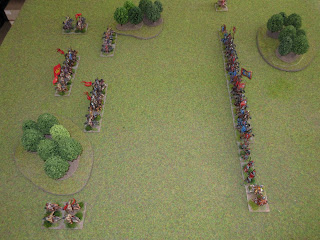In 359, Shapur II launched his second campaign against Rome with the invasion of southern Armenia, but encountered stubborn resistance by the valiant defence of the fortress of Amida. Finally surrendering after a seventy-three-day siege, Constantius II made massive preparations to include support from the royal houses of Armenia. Crossing the frontier of Perse-Armenia, Constantius II encountered the Sassanid army encamped a day’s march distance and prepared to do battle.
The open
plain between both armies allowed for ample room to deploy with a range of
hills serving as a backdrop for the ensuing battle. Along the length of the
Sassanid battle line, the Asavaran banners could be seen in an array of colour
which sharply contrasted with the Armenian loyalist lacking any, but
recognisable by their armoured cavalry.
Rome deployed in two lines, the first, the shields of elite units of palatine legions and auxilia could be seen and behind them, fluttered the draco standards of the Roman cavalry.
The Sassanid plan was simple, eliminate the Armenian allies of Rome as this would ensure the loyalty of their own allies eager to continue their position to rule. To this end, the Sassanid right wing launched its attack while the central command advanced forward at a walk to support.
The Sassanid assault against the Armenian wing was vigorously led and prompted the repositioning of Roman equites to bolster their line. The Roman centre was also affected as it came under rapid volley fire by Asavaran cavalry forcing auxilia back.
The Sassanid effort continued unabated, finally splitting the Armenian line sending many units fleeing. The effort to break the Armenian wing however, had come at a high cost, as the Sassanid wing was spent (also demoralised) and could only hold their position.
Meanwhile, Rome had not been idle and had similar ideas to deal with the Armenian usurpers on the Sassanid left. The Roman right wing bore down on enemy to clash with the mixed formations of Sassanid and their allies. The combined effort of clibanarii and palatine units proved so effective, the Sassanid of the left wing fled the field.
By mutual agreement, both forces in centre gradually drew apart; the Sassanid leaving the field to Rome with Rome too exhausted to pursue. Rome would record the battle as a victory, but their allies would have another tale to tell.
Comments
We do not
game many big battle games due to their necessitation too much time to play. This
big battle game took an hour and forty minutes to complete and in that time two
double size games can be played. The exercise did stimulate some ideas to
continue ‘campaigning’ in Armenia.
Rome: II/78b two commands eastern imperials. a third command of Armenian allies: II/28c
Sassan: II/69b three commands with 6
elements representing Armenian loyalists.











